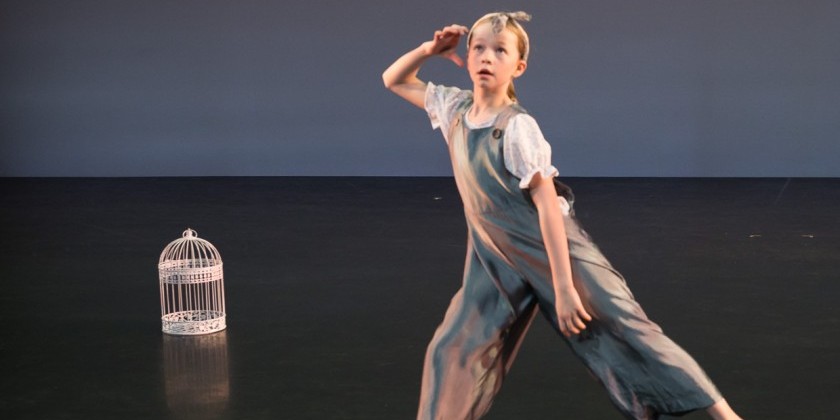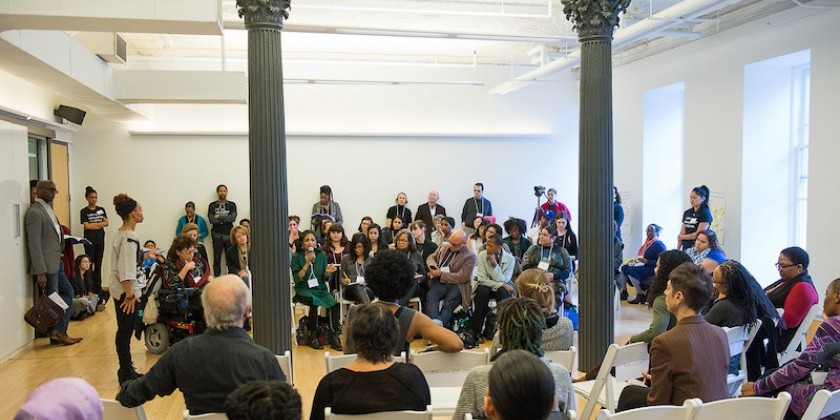Rebecca Lazier's "There Might Be Others"

The Choreographer and her International Cast Prepare for the Premiere
There Might Be Others
March 16-19, 7:30pm
New York Live Arts, 219 W 19th St., Chelsea
Choreographer: Rebecca Lazier
Composer: Dan Trueman in collaboration with Mobius Percussion and Sō Percussion
Pictured Above L-R: Kaya Kolodziejczyk, Agnieszka Kryst, Simon Courchel, Ramona Nagabczynska
Photo by Jakub Wittchen for Art Stations Foundation by Grażyna Kulczyk
For tickets go to New York Live Arts
Sitting in on a rehearsal for Rebecca Lazier’s There Might Be Others on the second day the full cast was assembled, I thought the dancers had been working together for months.
Later, I learned that the intense connection I sensed in the room was a function of the task Lazier has created in her new work, There Might Be Others. It is inspired by minimalist composer Terry Riley’s In C, a 1964 composition which consists of 53 numbered musical phrases that musicians can move through as they please. In similar fashion, Lazier has assembled an score of movement “modules” ranging from interactive games, to gesture, to abstract movement. The dancers must improvise and make decisions as they go, but unlike in Riley’s indeterminate work, Lazier has also crafted highly specific rules that govern how dancers move through the score. For example, dancers must proceed in order and remain within three modules of one another at all times. In order to execute these tasks, the performers watch each other intently, but they also preserve a sense of play.
There Might Be Others features live music by composer Dan Trueman, whose score also is an exploration of the principles of In C. The musicians, a rotating ensemble of percussionists, perform their own modules according to similar rules. They play with medium as well as structure, occasionally breaking from their instruments to make sound by tearing paper or passing around pocket change.

Photo by Jakub Wittchen for Art Stations Foundation by Grażyna Kulczyk
Lazier developed her work through a series of international residencies in Poland, Turkey, and Canada, ultimately inviting dancers from each of these locations to perform in the New York premiere. During each of the residencies, Lazier brought along a few of her New York-based dancers to help stage the piece. Thus, certain segments of the multinational cast had performed together before I saw them in rehearsal, but the others had not yet met. However, because all of the dancers – fifteen in this iteration – retain the freedom to make choices within the structure, the dance could turn out differently every time even if it were performed by the same cast.
“You can’t reenact the piece,” says Lazier. “It’s a process of constant change.” For the dancers and musicians, the challenge is to find balance: between individual agency and collective action, between structure and spontaneity. Though they all know the order of the modules, none of them know exactly what is going to happen next. The modules have no predetermined length, and not all the performers have to execute the same module at once.
“They have to be such an intelligent group,” Lazier said. “They have to find what’s going to happen next, but not with caution or suspicion.”

Photo by Jakub Wittchen for Art Stations Foundation by Grażyna Kulczyk
In earlier drafts, Lazier was more lax with the rules. At first, she allowed the dancers to move through the modules at whatever pace and in whatever order they wanted, more like In C. One set of modules – there are four total – took two hours. Lazier was not pleased with the result. “There have been some real battles,” she said. “I don’t want to stage confusion.” To that end, she crafted more specific rules and brought in dramaturg Naomi Leonard, a Princeton University professor who studies group decision making and collective motion.
However much of the underlying structure Lazier decides to show her audiences this week at New York Live Arts, it will likely be impossible for them to grasp every rich layer in one viewing. Eventually, though, all will be revealed: Lazier and her collaborators have put together a book detailing the score and its related rules, which will be released after the premiere.
Share Your Audience Review. Your Words Are Valuable to Dance.
Are you going to see this show, or have you seen it? Share "your" review here on The Dance Enthusiast. Your words are valuable. They help artists, educate audiences, and support the dance field in general. There is no need to be a professional critic. Just click through to our Audience Review Section and you will have the option to write free-form, or answer our helpful Enthusiast Review Questionnaire, or if you feel creative, even write a haiku review. So join the conversation.











